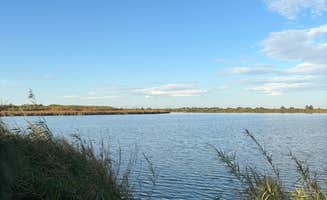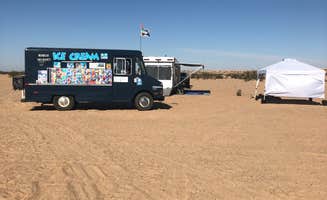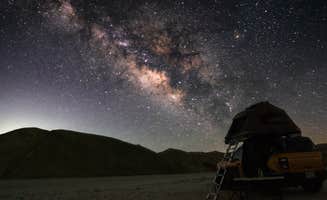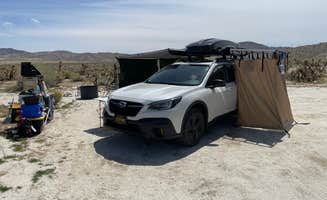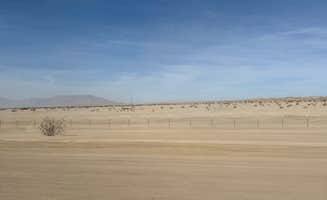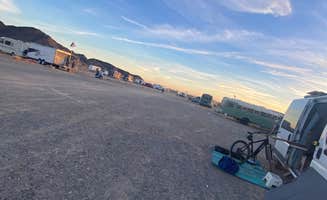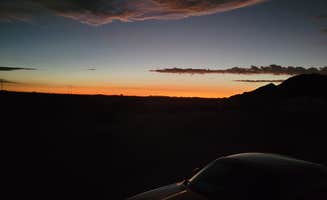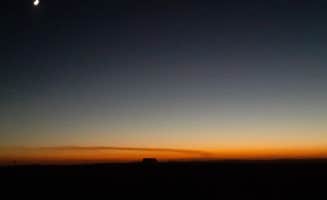Dispersed camping near El Centro, California takes place primarily on BLM land across a desert landscape with elevations ranging from 42 feet below sea level to several hundred feet above. Temperature extremes define this region, with summer highs regularly exceeding 110°F and winter nights dropping to the 40s. Areas like Truckhaven, Mountain Palm Springs, and the Imperial Sand Dunes offer distinctly different terrain with specific access considerations for each location.
What to do
Explore mud caves: At Arroyo Tapiado Mud Caves, campers can explore a unique geological formation. "There are more than five different areas to camp in this box canyon. The caves are cool, dark, and spooky! No matter how hot it is in the desert the caves are always about 60F," notes Dyl A. Bring proper lighting equipment as the interior passages remain consistently cool regardless of outside temperatures.
Visit hot springs: The thermal pools at Holtville Hot Springs provide a natural spa experience in the desert. "We loved this spot. FREE Dispersed camping is located just past power lines behind the actual hot springs," reports Chandra B., who adds that "It is well maintained by camp host Bill. Vault toilets, with TP & bonus there is great food at The Holtville Taco Shop 7 miles from springs."
Off-road exploring: The extensive trail systems throughout the region provide excellent off-roading opportunities. "We went all the way to the top and found an abandoned building. It was super creepy and a lot of fun!" shares a visitor to Truckhaven at Ocotillo Wells State Vehicle Recreation Area. Many locations require high-clearance vehicles, with some routes accessible only by 4WD.
What campers like
Stargazing opportunities: Clear desert skies create exceptional stargazing conditions at most dispersed sites. "Night skies are spectacular!" notes Shainna M. about Truckhaven at Ocotillo Wells State Vehicle Recreation Area. The minimal light pollution combined with open terrain allows for unobstructed celestial viewing.
Wildlife viewing: The Salton Sea area attracts numerous bird species. Red Hill Marina Park sits near the Salton Sea National Wildlife Refuge, which a camper describes as a "Major plus is birding at the Salton Sea National Wildlife Refuge." While the camping area itself receives mixed reviews, the wildlife viewing opportunities remain exceptional.
Temperature refuges: The desert climate creates natural temperature variations that campers can use strategically. "No matter how hot it is in the desert the caves are always about 60F," reports a camper about the mud caves. This provides a natural cooling option during hot days without requiring electricity or extra equipment.
What you should know
Permits and fees: While many areas offer free camping, some require permits or fees. The Imperial Sand Dunes Recreation Area requires weekly or seasonal passes during peak season. "This place isn't actually free you need to buy either a weekly or season pass which runs from November to April ($35 or $150) and the longest you can stay is two weeks without moving your set-up," explains a camper at Gordon's Well Sand Dunes.
Weather considerations: Desert conditions mean extreme temperatures and occasional high winds. As one visitor to Truckhaven notes, "In some weather conditions the wind can be a bit much." Flash flooding poses serious risks during rain events, with cave areas particularly dangerous. "Don't come here if it's going to rain because the cliff-sides may fall and block the trail," warns a mud caves visitor.
Sand management: Soft sand conditions affect vehicle access and camping comfort throughout the region. At Gordon's Well, "The sand is soft, heavy rigs may need to air down." For tent campers, specialized equipment helps. One camper at the mud caves advises, "Take sand capable tent pegs and set up site later in the day and not on a nice hill."
Tips for camping with families
Safety precautions: Cave exploration requires proper preparation. "Dates & Weather: March 12, 2021. Night temps weren't too bad down in the canyon we stayed in, mid-40's and during the day it was 50 with high winds up on top of the dirt mountains(?), caves were warmest the whole time," reports a visitor to the mud caves. Bring flashlights and avoid camping near unstable walls.
Accessible locations: Some areas provide easier access for families with children. Mountain Palm Springs Camp offers a more structured primitive camping experience. "Primitive camping. First come..., requires payment in envelope," notes Andy B. The more defined nature of this site may suit families better than completely undeveloped areas.
Food planning: Limited services mean bringing adequate supplies. Near Holtville Hot Springs, "There is great food at The Holtville Taco Shop 7 miles from springs. The Del Sol market has great marinated chicken for the BBQ and the tortillas are best outside of Mexico I have found," shares one camper. These food sources provide options for resupply without long travel distances.
Tips from RVers
Site selection: Finding level, stable ground proves crucial for larger rigs. "There are a lot of regulars who come to the dunes for group camping, and some of them have incredible set-ups," reports a camper at the Imperial Sand Dunes. Arriving early during busy periods helps secure suitable locations.
Road conditions: Access roads vary significantly in quality. At Finney Lake Camp, one visitor notes, "GPS will try to take you onto the wrong end of Williams Road, you need to go on Titsworth -> Smith -> then Williams." Many GPS directions prove unreliable, with local knowledge or detailed research necessary.
Utility management: No hookups exist at most dispersed sites. A camper at Gordon's Well advises, "You can pay to dump and fill up water at the RV park a couple miles from here." Planning for completely self-contained operation remains essential, with nearby services available for periodic tank management.



